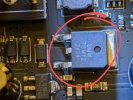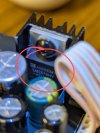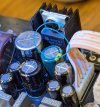-
Welcome to ASR. There are many reviews of audio hardware and expert members to help answer your questions. Click here to have your audio equipment measured for free!
- Forums
- Audio, Audio, Audio!
- Amplifiers, Phono preamp, and Analog Audio Review
- Stereo and Multichannel Amplifier Reviews
You are using an out of date browser. It may not display this or other websites correctly.
You should upgrade or use an alternative browser.
You should upgrade or use an alternative browser.
Fosi Audio V3 Mono Amplifier Review
- Thread starter amirm
- Start date
ive recieved mine today and got curious what are the indicators for the newer version?Looks like I have the newest version with the +19 / +25 gain settings.
25/19dB gain on RCA instead of 31/25.ive recieved mine today and got curious what are the indicators for the newer version?
Written on above the RCA connector. There is a picture just a few post back with an old unit.
D
Deleted member 72219
Guest
Sounds like they’re trying to level match XLR and base RCA input, with the optional boost on the RCA gain switch being the same increase as before. As opposed to original/Kickstarter units like mine which provide three different gain levels when taking into account XLR versus the two higher RCA gain options.25/19dB gain on RCA instead of 31/25.
Written on above the RCA connector. There is a picture just a few post back with an old unit.
-Ed
The overall problem here is they're changing the design without any notice. The more worrying thing is that they changed the voltage regulator (#4,080) as well which can affect on the noise floor, sinad and so on. Basically what I'm saying here is the new unit can perform differently compare to the unit amir measured.Sounds like they’re trying to level match XLR and base RCA input, with the optional boost on the RCA gain switch being the same increase as before. As opposed to original/Kickstarter units like mine which provide three different gain levels when taking into account XLR versus the two higher RCA gain options.
-Ed
D
Deleted member 72219
Guest
Well that’s not good.The overall problem here is they're changing the design without any notice. The more worrying thing is that they changed the voltage regulator (#4,080) as well which can affect on the noise floor, sinad and so on. Basically what I'm saying here is the new unit can perform differently compare to the unit amir measured.
-Ed
well my mono's box have a sticker that says v3-mono-DE-new & ean with id X0025RUQ7,
unit itself i dont want to open right now, but gain markings are still 31/25, so that's why i asked, inside picture of the new one would probably help to be sure.
unit itself i dont want to open right now, but gain markings are still 31/25, so that's why i asked, inside picture of the new one would probably help to be sure.
D
Deleted member 72219
Guest
Hold up…you mean when you change from 25 to 31, it doesn’t get any louder, and when changing from 31 to 25, it’s no less loud? Hmm…I have 6 early Fosi Audio V3 Monos with 31dB/25dB gain switches that don't do anything. Some early production irregularities, I guess. I haven't measured the actual gain on these units.
-Ed
DavidMcRoy
Addicted to Fun and Learning
- Joined
- Jul 10, 2018
- Messages
- 709
- Likes
- 1,226
That's right.Hold up…you mean when you change from 25 to 31, it doesn’t get any louder, and when changing from 31 to 25, it’s no less loud? Hmm…
-Ed
I have pictures of the voltage regulators. The original version, I was backer #20, says 2404. The new version says 2424 - which does not correspond with the chip number Fosi asked me to verify, which 2576.
The old amp is circled blue, the new amp in red.
The old amp is circled blue, the new amp in red.
Attachments
Those are indeed the same 78M12 regulators. 24XX is the manufacturing date code, 24=year, XX=week.I have pictures of the voltage regulators. The original version, I was backer #20, says 2404. The new version says 2424 - which does not correspond with the chip number Fosi asked me to verify, which 2576.
The old amp is circled blue, the new amp in red.
(LM)2576 has 5 pins instead of 3 and my guess is it has a heatsink as well.
EDIT: Look at the right side of the board next to the other switch. There should be a chip with a heatsink. I think that's our guy.
Last edited:
the internals?
Hello. I was beginning to be interested in this amp. However, the two-amp bundle with a combined power supply at Amazon appears to show an extremely high failure rate, according to reviews written in as recently as last December. Has this issue been addressed by the company?
Nyarlathotep
Member
- Joined
- Jan 27, 2024
- Messages
- 29
- Likes
- 47
While, there are questions circulating about this forum about the reliability of these amps, the fact of the matter is, 8 or so negative reliability reviews out of a total of 21 reviews (currently showing in the link provided) isn't exactly what would be considered statistically significant. It could be 1000 of these were bought through Amazon, 21 reviewed, and 8 were bad. Which is a low failure rate. Or that 100 of these were bought, 21 reviewed, and 8 failed, which isn't great. Or that 15 were bought, 21 reviewed, and 8 failed, which would be quite poor, a bad lot, or just plain bad luck. Using Amazon reviews to infer reliability is full of caveats, questions, and asterisks. Be careful.Hello. I was beginning to be interested in this amp. However, the two-amp bundle with a combined power supply at Amazon appears to show an extremely high failure rate, according to reviews written in as recently as last December. Has this issue been addressed by the company?
Nyarlathotep
Member
- Joined
- Jan 27, 2024
- Messages
- 29
- Likes
- 47
FWIW, the single unit V3 Mono with 48v/5A PS listed at Amazon does not have the same negative ratio, but still has a very small rating pool of 155, with an average of 4.5. Again, still not a reliable data set due to its size, and the tendency for bias on Amazon's reviews.While, there are questions circulating about this forum about the reliability of these amps, the fact of the matter is, 8 or so negative reliability reviews out of a total of 21 reviews (currently showing in the link provided) isn't exactly what would be considered statistically significant. It could be 1000 of these were bought through Amazon, 21 reviewed, and 8 were bad. Which is a low failure rate. Or that 100 of these were bought, 21 reviewed, and 8 failed, which isn't great. Or that 15 were bought, 21 reviewed, and 8 failed, which would be quite poor, a bad lot, or just plain bad luck. Using Amazon reviews to infer reliability is full of caveats, questions, and asterisks. Be careful.
Old_School_Brad
Major Contributor
- Joined
- Sep 10, 2024
- Messages
- 1,864
- Likes
- 2,556
Yeah, that doesn't look good.Hello. I was beginning to be interested in this amp. However, the two-amp bundle with a combined power supply at Amazon appears to show an extremely high failure rate, according to reviews written in as recently as last December. Has this issue been addressed by the company?
The single amplifier gets different ratings.
I have them on the outside casethe internals?
Similar threads
- Poll
- Replies
- 336
- Views
- 48K
- Poll
- Replies
- 1
- Views
- 775
- Poll
- Replies
- 67
- Views
- 27K
- Replies
- 399
- Views
- 80K
- Poll
- Replies
- 337
- Views
- 92K




